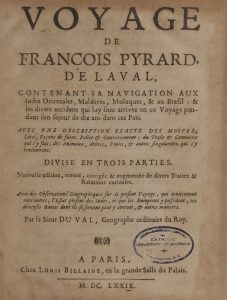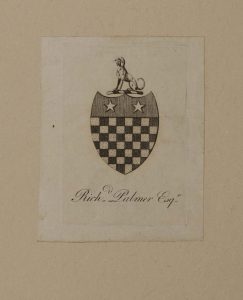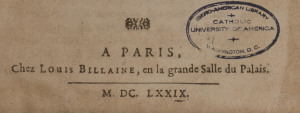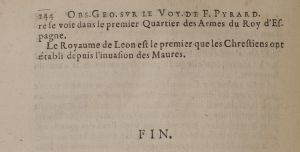Tracing John Locke’s path to the Oliveira Lima Library
Henry Widener
Despite our living in the Digital Age, Tumblr Share Your Shelf and articles such as the Washington Post’s These Books Spark Joy assert that a person’s bookshelf still has a lot to say about them. Peter Knox perhaps said it best: ‘Only a bookshelf can truly hold a reader’s history and future at the same time…Bookshelves are universal in that almost everyone has one, and unique in that no two collections are the same. They reflect much more than just the book-buying habits of their owner…” and can reveal our accomplishments, aspirations, associations, personal development, guilty pleasures, escapes, memories, interests and so much more.
The recognition of the deep connection between a person and their book collection is as old as the printed book itself. Just how intimately a book collector identifies with his collection can be observed most strikingly when that collector begins to sense the end of their bodily life approaching. Some collectors, such as Manoel de Oliveira Lima, desire to keep their collections entirely intact in perpetuity, somewhat of an attempt to communicate with posterity through a dialogue unadulterated by the passing of time. Other book collectors, whether by the constraints of economy, space or unsympathetic heirs, are forced to part with part or all of their books. Whatever their fate, book collections are inevitably linked to the memory of their former owners.
It is in this light that the personal library of John Locke has drawn attention from scholars. The most comprehensive study of the contents of Locke’s library is John Harrison and Peter Laslett’s The Library of John Locke (1971). This foundational text has served as a point of departure for an exploration into the intellectual influence of Locke’s library on his thinking, such as Richard Ashcraft’s John Locke’s Library: Portrait of an Intellectual (1969) and Ann Talbot’s The Great Ocean of Knowledge: the Influence of Travel Literature on the Work of John Locke (2010). Given Locke’s immense contribution to Modern Western thought, one might venture to say that the keener our knowledge of Locke’s personal library, the more we may understand about some of the thought processes that have influenced the world we live in today.
However, Locke’s library as he knew it did not remain intact after his passing. In his will, John Locke divided his collection into two parts, the first going to his cousin Peter King, the other going to Francis Cudworth Masham, son of Sir Francis and Damaris Masham, on whose Otes estate Locke spent the last 13 years of his life after returning to England from his voluntary exile in the Netherlands. These two parts of Locke’s library, known respectively as the King and Masham moieties, would experience very different fates. The King moiety would eventually find its way to the Bodleian Library at Oxford, where Locke himself had studied and taught. The Masham moiety, following the course of the disintegrating funds of the Masham family’s decadent successors, would be gradually dispersed throughout the world via auctions and other sales, leading Harrison and Laslett to conclude, in an almost wistful admission of defeat, that “We shall never set our eyes on more than a score or two of the Masham moiety” (Harrison and Laslett, p. 61)

Various institutions have been doing their part to assuage the gloom of these Locke scholars. Just last year the New York Academy of Medicine revealed that its copy of De Miraculis Occultis Naturae (1581) was part of the Masham Moiety. Today, it is the Oliveira Lima Library’s honor to contribute to these efforts to bring the Masham moiety further into light. Though unbridled my giddiness might lead me to prattle on forever, I would like to briefly relate how OLL came to discover that it possesses one of John Locke’s books.
Several months ago – eons in pandemic terms – we here at OLL decided to comb through Ruth Holmes Bibliographical and historical description of the rarest books in the Oliveira Lima collection at the Catholic University of America (1926). If nothing else, we hoped to familiarize ourselves with the only description of the Oliveira Lima Library’s holdings published under the guidance of Manoel de Oliveira Lima himself, a greatly useful resource for the various projects on provenance currently underway here at OLL, such as research into our Camiliana.

Entry n.102 in Holmes for Voyage de François Pyrard, de Laval, contenant sa navigation aux Indes orientales, Maldives, Moluques, & au Bresil (1679), (Fig. 1) states that “the fine copy in the Lima Library belonged to John Locke, and bears his autograph.” I immediately rushed to our Gale database to inspect every single page of the Oliveira Lima Library’s copy. While I did see the bookplate of a Richard Palmer Esq. (Fig. 2) I was unable to find any other provenance markings, much less an autograph, that could establish previous ownership by one of Modernity’s preeminent thinkers.
The Oliveira Lima Library’s previous cataloger seems to have reached the same results, for at the time, the book’s bibliographic record contained a note that the Oliveira Lima Library’s copy ‘supposedly’ contained John Locke’s signature. As other projects came about, I decided to file this tantalizing little conundrum away in hopes of someday getting back to it.
Months later, I opened David Pearson’s Provenance research in book history : a handbook (2019), which has become required reading at OLL for its straightforward yet in depth approach to provenance studies. In his chapter on inscriptions and manuscript additions, Pearson notes ‘a multiplicity of different marks and signs that can be used to detect the ownership of the philosopher John Locke (1632-1704) is described in the published reconstruction of his library’ (p. 37) accompanied by a footnote directing readers to Harrison and Laslett.

My interest was piqued again. A bit of Google sleuthing put me in contact with Sarah Wheale, Head of Rare Books at the Bodleian Library, who not only confirmed to me that François Pyrard’s Voyage (1679) did appear in Harrison and Laslett’s inventory, entry n. 2411 (Fig 3), but also attached Harrison and Laslett’s addendum on identifying Locke’s markings.

As I checked Harrison and Laslett’s addendum against the Oliveira Lima Library’s copy, my heart started beating quicker. Just as Harrison and Laslett state, on the title page the last two digits of the year of publication were underlined (Fig 4). Likewise, the page number on the last page of each of the book’s three parts was overlined. (Fig 5; Fig 6; Fig 7) After relating my findings to her through email, Sarah Wheale suggest I speak to Dr. Felix Waldmann, who confirmed that OLL’s Pyrard did previously belong to John Locke. At this point I was (figuratively) doing backflips!
Apart from all of the markings I had matched to Harrison and Laslett’s addendum, Dr. Waldmann pointed out that the bookplate of Richard Palmer, Esq. was further evidence of its having been part of the Masham moiety, for Palmer had been a creditor to the late Lord Masham and had thus taken possession of Masham’s library upon his death. Dr. Waldmann also provided me with a wealth of resources on Locke’s personal library, many of which I have cited here.

As a young professional, this incredibly gratifying process has given me firsthand experience of how exciting the field of bibliography and provenance studies can be, though they require a vast network of resources and often a meticulous attention to detail. It has also taught me some important lessons.
First of all, one should never hesitate to talk to colleagues in the field. It took me a good bit of time to build up the courage to send emails to the Bodleian Library, mostly out of fear that I might be bothering them with the pedestrian concerns of such a plebeian librarian as myself. However, I got over that fear by reasoning that there was potential mutual benefit to each of our institutions in locating another piece of John Locke’s library. To my delight, both Sarah Wheale from the Bodleian Library and Dr. Waldmann were incredibly helpful, vastly knowledgeable and just a joy to correspond with. I would like to take this opportunity to publicly express my gratitude to them both.

Secondly, I learned that one should think long and hard before rebinding their books. As I learned in conversation with Dr. Waldmann, OLL’s Pyrard may have been deprived of at least two other markings of Locke’s simply because it was rebound. For starters, John Locke’s unique shelf listing system – almost a dead giveaway for Locke provenance – is visible on the spines of all books from his library which have retained their original binding. Apart from the exterior of the book, rebinding can also alter the book itself. Oftentimes, and as is the case with OLL’s Pyrard, a book’s cover will be discarded and replaced with new endpapers once it has been rebound. This might explain the absence of Locke’s signature on OLL’s copy because, as Harrison and Laslett note, on the occasions that Locke did sign his books, his signature was always located on the back of the front cover.

Lastly, and this has become somewhat of a mantra among myself and OLL Director Dr. Nathalia Henrich, just because the Oliveira Lima Library’s holdings are strongest on the subject of Luso-Brazilian history does not mean that they are only of use to students of Portugal and Brazil. The Americas, both broadly as an immense swath of land rich in natural and cultural resources and more specifically as colonies, were inextricably linked to their European metropoles and inflamed the imaginations of the most diverse array of people throughout Europe, moving the march of history on either side of the Atlantic. Furthermore, the product of a life’s worth of collecting by a dedicated bibliophile, the Oliveira Lima Library has much to offer the fields of provenance research and bibliography, areas of research which in turn give proof that every collection is unique and deserving of study. The digitization of one copy of a book may provide access to the general contents of an edition, but it is no substitute for the study of the book as artifact. I can think of no better testament to this than the Oliveira Library’s copy of François Pyrard’s Voyage, a 17th-century description of travels through the New World written by a Frenchman and formerly owned by one of the greatest thinkers of the Enlightenment in England.
